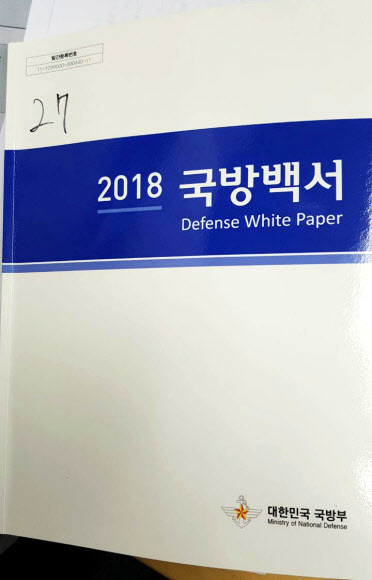Posted on : Jan.16,2019 16:41 KST
 |
|
The Ministry of National Defense’s 2018 Defense White Paper, published on Jan. 15, is the 23rd edition of the document since its launch in 1967.
|
Change reflects improvements in inter-Korean relations
 |
|
The Ministry of National Defense’s 2018 Defense White Paper, published on Jan. 15, is the 23rd edition of the document since its launch in 1967.
|
The color symbolizing the first defense white paper published under the administration of South Korean President Moon Jae-in is blue. The Ministry of National Defense (MND) explained its choice of colors as follows: “Blue symbolizes the future, trust and peace.” This hints at the reason for the disappearance of the language about the North Korean regime and military being South Korea’s “enemy.” The symbolic color can also be regarded as reflecting the relaxation of military tensions and the progress in inter-Korean relations since last year.’
It was in the 1990s that South Korea’s defense white papers began referring to the North Korean army as the South’s “main enemy.” The immediate cause of this reference was a remark by Pak Yong-su, the North Korean envoy to the eighth inter-Korean working-level meeting in 1994, while Kim Young-sam was president of South Korea. “If there is a war, Seoul will become a sea of fire,” Pak said during that meeting.
The reference to the North Korean army being South Korea’s “main enemy” was retained through 2000. In the 1998-2002 defense policy paper released by the administration of Kim Dae-jung in 2003, following the first inter-Korean summit on June 15, 2000, no mention was made of the “main enemy.” After Roh Moo-hyun became president, North Korea was referred to as a “direct military threat” (2004) and a “severe threat” (2006). It wasn’t until the sinking of the Cheonan corvette and the bombing of Yeonpyeong Island in 2010 that North Korea was once again described as South Korea’s “enemy.”
Nevertheless, the question of whether the expression “enemy” should be used in the defense white paper or whether such usage conforms to international standards is likely to remain controversial. Although the explicit description of North Korea as an “enemy” has been dropped from the white paper, it still says, “The Republic of Korea’s armed forces regard any forces that threaten and encroach upon our sovereignty, territory, people and assets as our enemies.”
“When we reviewed the language used by several countries that publish defense white papers, none of them refer directly to an ‘enemy.’ Most of them use the expression ‘threat.’ This question was discussed at length before the publication of the white paper, but we [ultimately] took into consideration the unique nature of inter-Korean relations and the attitudes of ordinary people,” said an official at the Defense Ministry.
Mention of arms control to guarantee military stability
This white paper devoted more space to the threat posed by North Korea’s missiles. The only North Korean missile with a range of 5,000km or more that appeared in the 2016 defense white paper was the Taepodong. This paper adds information about the Hwasong-12, Hwasong-13 and Hwasong-14 missiles, which have a range of more than 5,000-5,500km, and the Hwasong-15 missile, which has a range of over 10,000km.
“North Korea’s weapons of mass destruction are a threat to the peace and stability of the Korean Peninsula,” the white paper also said, though it added: “Our armed forces will provide military support to the effort to bring about lasting peace and the complete denuclearization of the Korean Peninsula and will continue to thoroughly prepare for every contingency.”
Another notable part of the white paper is its mention of “meaningful arms control.” “We will implement measures to guarantee military stability in connection with progress on inter-Korean exchange and cooperation projects and explore practical methods for arms control in line with progress toward building a peace regime and achieving denuclearization,” the white paper said.
The white paper also reflects changes in South Korea’s relations with Japan. The 2016 white paper said that South Korea and Japan “share the basic values of liberal democracy and a market economy,” but that language did not appear in this year’s white paper.
Changes in S. Korea-Japan relations and laws on conscientious objectors
On a different topic, the white paper describes the effort to give South Korean conscientious objectors an alternative to mandatory military service. “On June 28, 2018, the Constitutional Court decided that the Military Service Act was unconstitutional because it violated the freedom of conscience through its failure to provide an alternative form of service for those who object to military service for reasons including religious faith,” the white paper said. The MND faces criticism for misrepresenting the Constitutional Court’s decision, which actually says “conscientious objectors to military service,” not “those who object to military service for reasons including religious faith.”
The MND even delayed the publication of its white paper by one week so that it could abruptly change the term it uses to refer to those eligible for alternative service. In effect, the confusion caused by addressing a human rights issue from the narrow perspective of public opinion is fully evident in this white paper.
By Noh Ji-won, staff reporter, and Yoo Kang-moon, senior staff writer
Please direct comments or questions to [english@hani.co.kr]










